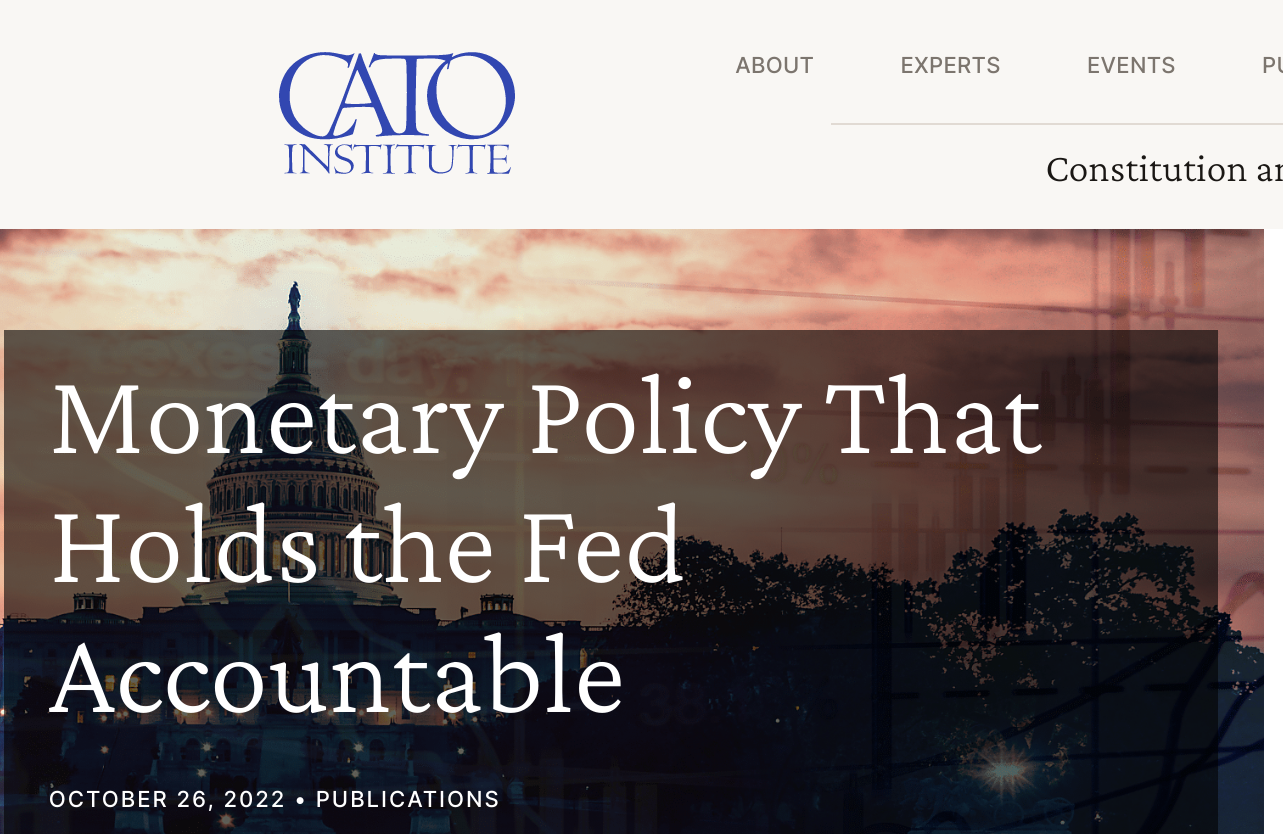
The Cato Institute has put out a new paper on reforming our financial system. Here are their recommendations on monetary policy:
Narrow the Fed’s statutory mandate. Congress should replace the Fed’s dual mandate with a single stable spending mandate. The mandate would require the Fed to maintain a stable, if steadily rising, level of total spending on goods and services or, in other words, a stable dollar value of national income. Congress should also repeal the financial stability mandates that it gave to the Fed in Title I of the Dodd–Frank Act.
Require the Fed to follow a policy rule. Congress should require the Fed to implement a simple rule that Congress can easily monitor and use to hold the Fed accountable. The rule should require the Fed to commit itself to maintaining a specific growth rate for nominal gross domestic product (NGDP), a popular measure of total spending. The specific rate, as well as other details, might be left to Fed officials to decide, but most experts would place the desirable growth rate of NGDP somewhere in the range of 3–5 percent.
Shrink the Fed’s balance sheet and reestablish a “scarce” reserve regime. In a scarce reserve regime, instead of holding substantial reserve balances, banks would economize on reserves. To make up for temporary reserve shortages, banks would turn to either the private repo market or the Fed’s Standing Repo Facility. To ensure that the Fed returns to a scarce reserve regime, Congress should insist that the Fed follow the 2006 Financial Services Regulatory Relief Act, a law that stipulates that the rate of interest the Fed pays on reserve balances should not exceed “the general level of short‐term interest rates.”
Those are basically my views, although I’d prefer to leave the Congressional monetary policy mandate as it is and have the Fed make the decision as to how best to fulfill the mandate. Let a different agency handle financial stability.
But the specific monetary policy proposals of Cato are sound, and would dramatically improve policy. All I would add is that the NGDP target definitely needs to be a level target, to minimize the risk of policy producing the sort of NGDP undershoot seen in 2008-09, or the overshoot seen in 2021-22. The biggest problem with current monetary policy is the lack of level targeting.

READER COMMENTS
Thomas Lee Hutcheson
Nov 17 2022 at 5:10pm
But in the face of a really large supply shock we would need a one-time increase in the implicit PL target (inflation temporarily above the implicit inflation target) to allow the new set of relative prices to emerge. FAIT seems wiser to me though either would be better than 2008-2020.
vince
Nov 17 2022 at 9:11pm
Per the Cato paper: “Because the Fed is also responsible for achieving financial stability, it really operates under a triple mandate.”
Financial stability as a mandate? Wow, there’s a justification for the Fed to micro-manage. Let’s not let a market correction interfere with financial stability.
It’s interesting how asset bubbles aren’t a financial stability problem, but a downturn sure is.
Spencer
Nov 18 2022 at 9:40am
The FED should try monetarism, controlling total legal reserves and not Volcker’s non-borrowed reserves. Banks are unique. Banks are credit creators, not credit transmitters. The lending capacity of the commercial banks is dependent upon monetary policy, not the savings practices of the nonbank public.
The bankers should never usurp the FED’s “open market power”. The FED should reimpose Reg. Q ceilings and gradually lower them. The banks should be driven out of the savings business, making them, and saver-holders, more profitable. I.e., it will raise the Real rate of interest for nonbank holders, e.g., pensioners.
But you’ll run into the real political power, the ABA.
Spencer
Nov 18 2022 at 9:50am
N-gDp level targeting has to have a defined mechanism by which the target is continually hit. I.e., someone, somewhere has to have a useable mathematical formula. I.e., someone, somewhere has to know something more about money and Central banking.
Spencer
Nov 18 2022 at 3:12pm
AD = M*Vt (where N-gDp is a subset and proxy). As American Yale Professor Irving Fisher said: “The is an exact science”.
Thomas Lee Hutcheson
Nov 18 2022 at 4:32pm
CATO would be a big improvement on the t 2008-2020 debacle but is inferior to a flexible average inflation target (FAIT) in that, if applied mechanically, it would not permit enough temporary inflation in the case of really large shocks that require large changes in relative prices to maintain full employment.I think the Fed’s “financial stability” mandate, if it is one, is probably dominated by FIAT. When would “financial stability” conflict with FIAIT?
Mark Brophy
Nov 18 2022 at 9:34pm
We need to abolish paper money and replace it with real money, gold. The alternative is to suffer inflation and high government spending.
Michael Sandifer
Nov 19 2022 at 12:18am
Yes, these are all good ideas. I’d prefer to just elimate the regulation, instead of shifting control of it elsewhere.
Comments are closed.